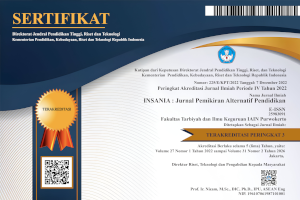The application design based on Mobile Assisted Language Learning (Mall) to improve reading comprehension
DOI:
https://doi.org/10.24090/insania.v29i2.8927Keywords:
application design, MALL, reading comprehensionAbstract
Mobile learning has become increasingly prevalent in the education sector as smartphones are now part of everyday life. This study focuses on designing a mobile application to enhance the reading comprehension skills of students at Politeknik Negeri Jakarta (PNJ). Mobile learning offers students the flexibility to access learning materials anytime and anywhere, overcoming the limitations of classroom teaching hours. The research aims to develop a prototype of a Mobile Assisted Language Learning (MALL) application for Android smartphones, specifically tailored to assist students in preparing for the reading comprehension section of the TOEIC (Test of English for International Communication) test. The methodology involves analyzing the needs of PNJ students through surveys and interviews to identify their challenges in learning English, particularly in reading comprehension. Based on the findings, a prototype application was designed using iterative development processes, integrating features such as interactive reading exercises, real-time feedback, and progress tracking. The prototype was tested with final-year students to evaluate its effectiveness. The results indicate that the application significantly improves students' reading comprehension skills, as evidenced by higher practice scores and positive user feedback. The findings highlight the potential of MALL in bridging the gap in practice opportunities and limited classroom learning time.This research recommends further development of the application to include other sections of the TOEIC test, such as listening comprehension, and the integration of gamified features to enhance user engagement. Additionally, collaboration with vocational educators is suggested to ensure the content aligns with industry needs and language proficiency standards.Downloads
References
Afflerbach, P., & Cho, B. Y. (2009). Identifying and describing constructively responsive comprehension strategies in new and traditional forms of reading. In S. E. Israel & G. D. Duffy (Eds.), Handbook of research on reading comprehension (pp. 69-90). Routledge.
Anshari, M., Almunawar, M. N., Shahrill, M., Wicaksono, D. K., & Huda, M. (2017). Smartphones usage in the classrooms: Learning aid or interference? Education and Information Technologies, 22(6), 3063-3079. https://doi.org/10.1007/s10639-017-9572-7
Babiker, M., & Elmagzoub, A. (2015). For effective use of multimedia in education, teachers must develop their own educational multimedia applications. Turkish Online Journal of Educational Technology-TOJET, 14(4), 62-68. https://doi.org/10.17718/tojet.20154
Fansury, A. H., Rahman, M. A., & Jabu, B. 2021. Developing mobile English application as teaching media: Pengembangan aplikasi bahasa Inggris sebagai media pembelajaran. Deepublish.
Fauziati, E., & Maftuhin, M. (2016). Interlanguage verb tense systems of Indonesian EFL learners. Journal of Foreign Languages, Cultures and Civilizations, 4(2), 72-82.
Gromik, N. A. (2012). Cell phone video recording feature as a language learning tool: A case study. Computers & Education, 58(1), 223-230. https://doi.org/10.1016/j.compedu.2011.08.017
Hashim, H., Yunus, M. M., Embi, M. A., & Ozir, N. A. M. (2017). Mobile-assisted language learning (MALL) for ESL learners: A review of affordances and constraints. Sains Humanika, 9(1-5). https://doi.org/10.11113/sh.v9n1-5.1175
Kohnke, L., Zhang, R., & Zou, D. (2019). Using mobile vocabulary learning apps as aids to knowledge retention: Business vocabulary acquisition. Journal of Asia TEFL, 16(2), 683. https://doi.org/10.18823/ASIATEFL.2019.16.2.16.683
Lindaman, D., & Nolan, D. (2015). Mobile-assisted language learning: Application development projects within reach for language teachers. IALLT Journal of Language Learning Technologies, 45(1), 1-22. https://doi.org/10.17161/iallt.v45i1.8547
Novianti, R., Hukmi, H., & Maria, I. (2019). Generasi Alpha–Tumbuh dengan gadget dalam genggaman. Jurnal Educhild: Pendidikan dan Sosial, 8(2), 65-70. https://doi.org/10.33578/jpsbe.v8i2.7667
Nushi, M., & Eqbali, M. H. (2018). Babbel: A mobile language learning app. TESL Reporter, 51, 13-13.
Pachler, N. (2010). The socio-cultural ecological approach to mobile learning: An overview. In Medienbildung in neuen Kulturräumen: Die deutschprachige und britische Diskussion (pp. 153-167). https://doi.org/10.1007/978-3-531-92133-4_11
Rahimi, M., & Miri, S. S. (2014). The impact of mobile dictionary use on language learning. Procedia - Social and Behavioral Sciences, 98, 1469-1474. https://doi.org/10.1016/j.sbspro.2014.03.567
Ramadhanti, S., Nursehan, S. P., & Abdullah, R. (2019). Implementasi pembelajaran bahasa Inggris berbasis mobile-assisted language learning (MALL) untuk generasi neo-milenial. JURMA: Jurnal Program Mahasiswa Kreatif, 3(2). https://doi.org/10.32832/pkm-p.v3i2.476
Sandberg, J., Maris, M., & de Geus, K. 2011. "Mobile English Learning: An Evidence-Based Study with Fifth Graders”. Computers & Education, 57, 1334-1347. https://doi.org/10.1016/j.compedu.2011.01.015
Soleimani, E., Ismail, K., & Mustaffa, R. (2014). The acceptance of mobile assisted language learning (MALL) among post graduate ESL students in UKM. Procedia - Social and Behavioral Sciences, 118, 457-462. https://doi.org/10.1016/j.sbspro.2014.02.062
Surjono, H. D. (2015). The effects of multimedia and learning style on student achievement in online electronics course. Turkish Online Journal of Educational Technology-TOJET, 14(1), 116-122. https://doi.org/10.1007/978-3-319-25607-4_8
Tynjälä, P. (2001). Writing, learning and the development of expertise in higher Education. In Writing as a learning tool: Integrating theory and practice (pp. 37-56). Springer Netherlands.
Tannenbaum, R. J., & Wylie, E. C. (2008). Linking English-language test scores onto the Common European Framework of Reference: An application of standard-setting methodology. ETS Research Report Series, 2008(1), i-75. https://doi.org/10.1002/j.2333-8504.2008.tb02120.x
Yudhiantara, R. A., & Saehu, A. (2017). Mobile-assisted language learning (MALL) in Indonesian Islamic higher education. IJELTAL (Indonesian Journal of English Language Teaching and Applied Linguistics), 2(1), 1-10. https://doi.org/10.21093/ijeltal.v2i1.52
Downloads
Published
How to Cite
Issue
Section
License
Copyright (c) 2024 Yogi Widiawati, Elitaria Siregar, Iwan Sonjaya

This work is licensed under a Creative Commons Attribution-ShareAlike 4.0 International License.
Authors who publish with this journal agree to the following terms:
Authors retain copyright and grant the journal right of first publication with the work simultaneously licensed under a Creative CommonsAttribution-ShareAlike License that allows others to share the work with an acknowledgment of the work's authorship and initial publication in this journal.
Authors are able to enter into separate, additional contractual arrangements for the non-exclusive distribution of the journal's published version of the work (e.g., post it to an institutional repository or publish it in a book), with an acknowledgment of its initial publication in this journal.
Authors are permitted and encouraged to post their work online (e.g., in institutional repositories or on their website) prior to and during the submission process, as it can lead to productive exchanges, as well as earlier and greater citation of published work (See The Effect of Open Access).








